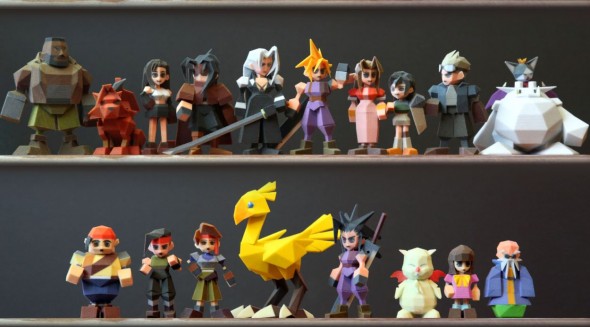Rapid Ready Roundup: Sintercore, 3D Printed Most Wanted, Stratasys Materials, and Final Fantasy

Final Fantasy 7 characters printed out in all their blocky glory. Courtesy of Shapeways.
Latest News
August 20, 2013
In the course of my diligent efforts to keep you good people up to date on the state of additive manufacturing (AM), I come across many interesting news items. I’ll gather them up every so often and present them in a Rapid Ready Roundup (like this one). You can find the last Roundup here.
We’ll start today’s Roundup with a bang. Sintercore, a small company founded by former US Marine Neal Brace, has developed a muzzle break for the AR-15 using AM. The complex internal geometry of the muzzle break could only be produced through AM, and leads to a reduction of muzzle rise and recoil. The muzzle break, named Auxetik, was built from Inconel, an alloy generally used to build parts for jet engines.
Brace is able to reproduce the part for just $300 by sending orders to services bureaus, which then print it out on professional metal AM systems. Brace claims he has other firearms peripherals in the works, but is quick to distance himself from entities like Defense Distributed. According to Brace, not only is he not in the business of printing guns, he doesn’t intend to start.
Moving on, police in Japan have found a new use for AM by printing out busts of wanted criminals and terrorists. The project has already been successful in helping to capture the last member of Aum Shinrikyo, the terrorist group responsible for the 1995 subway sarin gas attack. The fugitive Katsuya Takahashi was arrested at a manga cafe after the bust’s release, which apparently gave people a better idea of what his overall appearance.
In addition to printing out the heads of criminals, Japanese police are looking to use AM to print out replicas of weapons used in attacks, and to build scale models of crime scenes. These props may find their way into jury rooms, where they will be used to assist prosecutors (and eventually defenders, no doubt) as part of the proceedings. The video below is in Japanese, but you can set it up for English captions.
Next, we have a quick word about Stratasys’ material options. At last count the company was up to more than 130 different materials including the PolyJet and Fused Deposition Modeling processes. That many materials presents a daunting amount of information for customers to absorb, and Stratasys has decided to ease the burden by releasing a series of videos focused on materials. You’ll find the first such video below.







